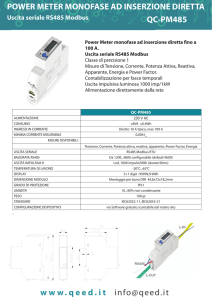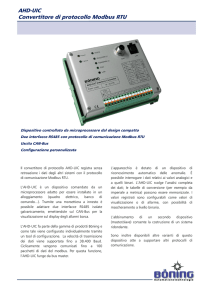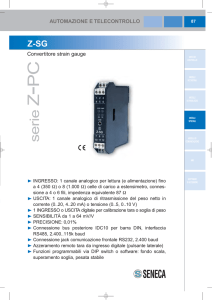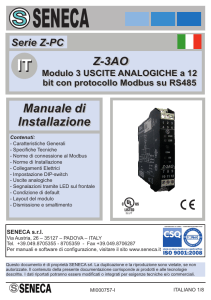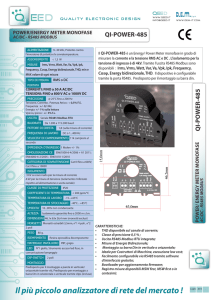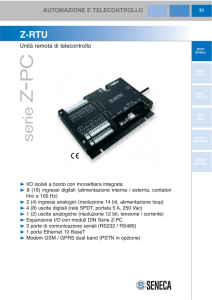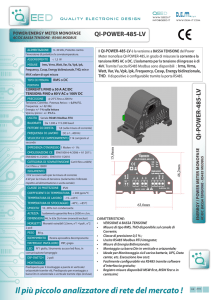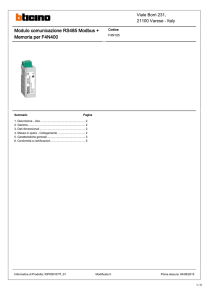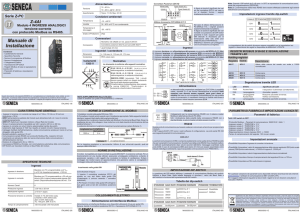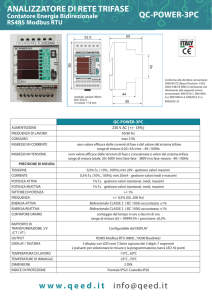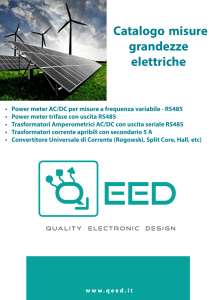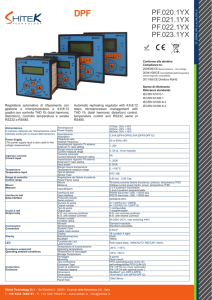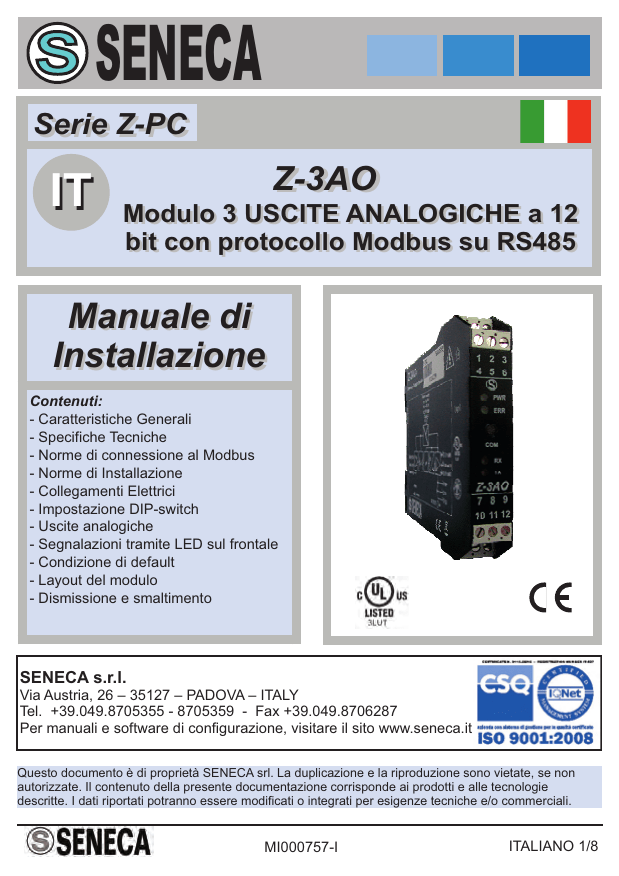
S SENECA
Serie
Serie Z-PC
Z-PC
IT
Z-3AO
Z-3AO
Modulo
Modulo 33 USCITE
USCITE ANALOGICHE
ANALOGICHE aa 12
12
bit
bit con
con protocollo
protocollo Modbus
Modbus su
su RS485
RS485
Manuale di
Installazione
Contenuti:
- Caratteristiche Generali
- Specifiche Tecniche
- Norme di connessione al Modbus
- Norme di Installazione
- Collegamenti Elettrici
- Impostazione DIP-switch
- Uscite analogiche
- Segnalazioni tramite LED sul frontale
- Condizione di default
- Layout del modulo
- Dismissione e smaltimento
SENECA s.r.l.
Via Austria, 26 – 35127 – PADOVA – ITALY
Tel. +39.049.8705355 - 8705359 - Fax +39.049.8706287
Per manuali e software di configurazione, visitare il sito www.seneca.it
Questo documento è di proprietà SENECA srl. La duplicazione e la riproduzione sono vietate, se non
autorizzate. Il contenuto della presente documentazione corrisponde ai prodotti e alle tecnologie
descritte. I dati riportati potranno essere modificati o integrati per esigenze tecniche e/o commerciali.
MI000757-I
ITALIANO 1/8
Prima di effettuare qualsiasi operazione è obbligatorio leggere tutto il contenuto del presente
Manuale. Il modulo deve essere utilizzato esclusivamente da tecnici qualificati nel settore delle
installazioni elettriche.
La riparazione del modulo o la sostituzione di componenti danneggiati deve essere effettuata
dal Costruttore.
La garanzia decade di diritto nel caso di uso improprio o manomissione del modulo o dei dispositivi
forniti dal Costruttore necessari per il suo corretto funzionamento, e comunque se non sono state
seguite le istruzioni contenute nel presente Manuale.
CARATTERISTICHE GENERALI
3 uscite analogiche impostabili in corrente o in tensione a 12 bit di risoluzione.
Inizio e fondo scala in tensione bipolare programmabile a -10 – 10 V, 0 – 10 V o 2 – 10 V.
Inizio e fondo scala in corrente programmabile a 0 – 20 mA o 4 – 20 mA.
Isolamento delle uscite 1500 V~ rispetto ai restanti circuiti in bassa tensione.
Uscite protette con soppressori di transienti da 400 W/ms; protezione del carico
utilizzatore mediante PTC.
Connessione a negativo comune.
2
Morsetti estraibili a sezione 2.5 mm .
Ridotto tempo di risposta (10-90%): tipico < 50 ms.
Possibilità di cablaggio facilitato dell'alimentazione e della linea seriale per mezzo di
un bus alloggiabile nella guida DIN, in alternativa ai morsetti.
Comunicazione seriale RS485 con protocollo Modbus-Rtu, massimo 64 nodi.
Connessione RS232 con protocollo Modbus sul frontale per comunicazione seriale
o anche per programmazione.
Inserimento ed estrazione dal bus senza interruzione della comunicazione
o dell'alimentazione del sistema.
Tempi di comunicazione inferiori a 10 ms (@ 38400 Baud).
Distanza di collegamento fino a 1200 m.
DIP-Switch per settare indirizzo e Baud Rate del modulo.
SPECIFICHE TECNICHE
Uscite
Uscita in tensione
-10 – 10 V, 0 – 10 V, 2 – 10 V. Impedenza pilotabile > 600 W
Uscita in corrente
0 – 20 mA, 4 – 20 mA. Impedenza pilotabile < 600 W
Numero Canali
3
Risoluzione uscita tensione 12 bit (5 mV)
Risoluzione uscita corrente 12 bit (5 µA)
Errori uscita tensione
Calibrazione: 0.2% del F.S. Max, 0.1% tipico
Linearità: 0.05% del F.S.
Stabilità termica: 0.01%/°C del F.S.
Errori uscita corrente
Calibrazione: 0.2% del F.S. max, 0.1% tipico
Linearità: 0.05% del F.S.
Stabilità termica: 0.01%/°C del F.S.
MI000757-I
ITALIANO 2/8
Alimentazione
Tensione
10 – 40 V~;19 – 28 V~ 50 – 60 Hz
Assorbimento
Tipico: 1,5 W @ 24V~, Max: 3.2 W
Condizioni ambientali
Temperatura
-10 – +65°C (-10 – +55 °C UL)
Umidità
30 – 90% a 40°C non condensante
Altitudine
Fino a 2000 m s.l.m.
Temperatura di stoccaggio
-20 – +85°C
Grado di Protezione
IP20
Connessioni
Morsetti a vite estraibili a 3 vie, passo 5 mm
Connettore posteriore IDC10 per barra DIN 46277
Jack frontale 3.5 mm
Ingombri / contenitore
Dimensioni
L: 100 mm; H: 112 mm; W: 17,5 mm
Contenitore
PBT, colore nero
Isolamenti
1500 V~
IDC10
4 5 6
RS485
7
8
Normative
Lo strumento è conforme alle seguenti normative:
EN61000-6-4 (emissione elettromagnetica, in
ambiente industriale).
EN61000-6-2 (immunità elettromagnetica, in
ambiente industriale).
Uscite
Analogiche
EN61010-1 (sicurezza).
9
Alimentazione
2 3
IDC10
1500V~
NOTE SUPPLEMENTARI SULL’UTILIZZO:
Usare in ambienti con grado di inquinamento 2.
L’alimentatore deve essere di classe 2.
Un fusibile di portata max di 2,5 A deve essere installato in prossimità del modulo.
MI000757-I
ITALIANO 3/8
Norme di connessione al Modbus
1) Installare i moduli nella guida DIN (max 120)
2) Connettere i moduli remoti usando cavi di lunghezza appropriata. Nella seguente
tabella si riportano i dati relativi alla lunghezza dei cavi:
-Lunghezza bus: lunghezza massima della rete Modbus in funzione del Baud Rate.
Questa è la lunghezza dei cavi che collegano i due moduli su cui è stata inserita la
terminazione del bus (vedere Schema 1).
-Lunghezza derivazione: lunghezza massima di una derivazione 2 m(vedere Schema 1) .
Schema 1
Lunghezza
bus
Lunghezza
derivazione
1200 m
2m
Modulo4
Modulo3
Terminatore
Modulo1
Ld
Terminatore
Modulo5
Modulo2
Lunghezza del bus
Ld = Lunghezza derivazione
Per le massime prestazioni si raccomanda l’utilizzo di cavi schermati speciali, quali ad
esempio il BELDEN 9841.
Norme di installazione
Il modulo è progettato per essere montato su guida DIN 46277, in posizione verticale. Per
un funzionamento ed una durata ottimali, assicurare un’adeguata ventilazione, evitando di
posizionare canaline o altri oggetti che occludano le feritoie di ventilazione. Evitare il
montaggio dei moduli sopra ad apparecchiature che generano calore. Si consiglia il
montaggio nella parte bassa del quadro elettrico.
Inserimento nella guida DIN
Come illustrato in figura:
1) Inserire il connettore posteriore IDC10 del
modulo su uno slot libero della guida DIN
(l’inserimento è univoco essendo i connettori
polarizzati).
2) Per fissare il modulo nella guida DIN
stringere i due ganci posti ai lati del
connettore posteriore IDC10.
Collegamenti elettrici
Alimentazione ed interfaccia MODBUS
Alimentazione ed interfaccia Modbus sono disponibili utilizzando il bus per guida DIN
Seneca, tramite il connettore posteriore IDC10, o l’accessorio Z-PC-DINAL2-17,5.
MI000757-I
ITALIANO 4/8
Connettore Posteriore (IDC10)
Power Supply AC / +
RS485 GND
Power Supply AC / -
RS485 A
1
RS485 B
IDC 10
In figura si riporta il significato dei vari pin
del connettore IDC10 nel caso in cui si
desideri fornire i segnali direttamente
tramite esso.
Uso Accessorio Z-PC-DINAL2-17,5
Nel caso di utilizzo dell’accessorio Z-PCDINAL2-17,5, i segnali possono essere
forniti tramite morsettiere. In figura si
riporta il significato dei vari morsetti e la
posizione del DIP-switch (presente in tutti i
supporti per guida DIN elencati in
Accessori) per la terminazione della rete
CAN (non usata nel caso di rete Modbus).
GNDSHLD: Schermo per proteggere i
segnali dei cavi di connessione dai disturbi
(consigliato).
Tensione
#OUT3
V
V
mA
+
8
9
+
7
#OUT2
+
#OUT1
V
GND
Corrente
mA
mA
Uscite analogiche
I morsetti 10,11 e 12 sono tra loro
connessi internamente. Le uscite sono
disponibili ai morsetti 7,8 e 9 e possono
essere impostate in corrente o in tensione
mediante DIP-switches.
10
11
12
Alimentazione
In alternativa alla connessione mediante bus Z-PC-DINx, è possibile
usare i morsetti 2 e 3 per fornire l'alimentazione al modulo. I Iimiti
2 superiori non devono essere superati, pena gravi danni al
3 modulo.Nel caso in cui la sorgente di alimentazione non sia protetta
contro il sovraccarico, è necessario inserire un fusibile nella linea di
alimentazione: valore massimo 2.5 A.
19 – 28 V~
50 – 60 Hz
10 – 40 V~
MODBUS RS485
GND
B(-)
A(+)
4
5
6
Collegamento per la comunicazione RS485 con il sistema master
Modbus in alternativa al bus Z-PC-DINx.
N.B. L’indicazione della polarità della connessione RS485 non è
standardizzata, su alcuni master potrebbe essere invertita
MI000757-I
ITALIANO 5/8
MODBUS RS232
Il modulo è progettato per scambiare dati secondo le modalità definite dal protocollo
MODBUS. La comunicazione RS232 ha la priorità sulla comunicazione RS485.
Questa porta di comunicazione può essere usata per comunicare ed anche per
programmare il modulo.
La porta seriale RS232 usa i seguenti parametri di comunicazione:
2400,8,N,1
La porta di comunicazione COM si comporta esattamente come quella del bus RS485
eccetto che per i parametri di comunicazione. Durante l'uso della porta RS232 il bus
risulterà inattivo; si riattiverà automaticamente dopo alcuni secondi dall'ultimo messaggio
scambiato sulla porta COM.
EASY SETUP è il software da utilizzare per la configurazione.
PORTA SERIALE RS232
Il modulo è provvisto di un connettore
Jack Femmina che permette il
collegamento al bus di comunicazione
RS232. Il cavo di connessione:
DB9 – Jack stereo 3.5 mm può essere
assemblato come indicato nella figura,
oppure acquistato come accessorio:
(cod. PM001601).
9 5
GND
Tx
6
Rx
1
Jack stereo 3.5 mm
DB9-F
GND Tx
Rx
Impostazione dei DIP-Switch
La posizione dei DIP-switch definisce i parametri di comunicazione Modbus del modulo:
Indirizzo e Baud Rate. Nella tabella seguente si riportano i valori del Baud Rate e
dell’Indirizzo in funzione dell’impostazione dei DIP-switch:
Stato dei DIP-Switch
SW1 POSIZIONE
12 3 4 5 6 7 8
BAUD
RATE
TERMINASw1 POSIZIONE INDIRIZZO
SW3
TORE
12 3 4 5 6 7 8
POSIZIONE
zz x x x x x x
9600
x x z z z zz y
#1
z
Disabilitato
zy x x x x x x
19200
x x z z z zy z
#2
y
Abilitato
yz x x x x x x
38400
xx . . . . . .
#..
yy x x x x x x
57600
x x y y y yy y
# 63
y
ON
x x z z z zz z
From
EEPROM
x x z z z zz z
From
EEPROM
z
OFF
Nota: Quando i DIP Switch da 3 a 8 sono in OFF, le impostazioni di comunicazione sono
prese da programmazione (EEPROM).
MI000757-I
ITALIANO 6/8
Terminazione della linea RS485
1
ON
0
OFF
SW3
TERMINATOR
La terminazione della linea
RS485 deve essere effettuata
solamente agli estremi della
linea di comunicazione.
Impostazioni uscite
SW1 USCITE ANALOGICHE
# ON Uscita in corrente
CANALE CANALE CANALE
1
2
3
$ OFF Uscita in tensione
Su di un lato del modulo sono
presenti tre deviatori, che
consentono di scegliere
indipendentemente per ogni
canale l’uscita in tensione o in
corrente. Tale uscita (se in
tensione o in corrente) viene
automaticamente
riconosciuta dal modulo.
Si consiglia di settare i DIPswitch a modulo spento.
Uscite analogiche
Registri MODBUS: Holding registers
Registro Nome Descrizione
40005
OUT CH1 Valore dell’uscita analogica: i valori ammessi sono:
40006
da
0 a 10000 uscita in corrente 0 – 20 mA, 4 – 20 mA oppure
da -10000 a 10000 uscita in tensione 0 – 10V, 2 – .10V, -10 – 10V
in relazione allo stato dei flags del registro EPRFLG.
Il valore memorizzato in EEPROM verrà utilizzato come default
all’accensione e alla scadenza del timeout se viene attivata la
funzione di sicurezza (vedi MANUALE UTENTE).
OUT CH2 Come precedente
40007
OUT CH3 Come precedente
Impostazioni avanzate
Possibilità di impostare IS (l’inizio scala ) e FS (il fondo scala) dell’uscita desiderata.
Possibilità impostare un timer di sicurezza che dopo un tempo programmato porta le uscite
in uno stato di sicurezza predefinito.
Possibilità di impostare lo stato di sicurezza delle uscite, questo verrà attivato nel caso di
mancata comunicazione per un tempo uguale a quello impostato nel timer di sicurezza.
MI000757-I
ITALIANO 7/8
Segnalazioni tramite LED sul frontale
LED
STATO
Significato dei LED
PWR Verde
Acceso fisso
Il dispositivo è alimentato correttamente.
FAIL Giallo
Lampeggiante
Impostazioni errate.
FAIL Giallo
Acceso fisso
Anomalia o guasto.
RX Rosso
Lampeggiante
Ricezione pacchetto avvenuta.
RX Rosso
Acceso fisso
Verifica connessione.
TX Rosso
Lampeggiante
Trasmissione pacchetto avvenuta.
TX Rosso
Acceso fisso
Verifica connessione.
Condizione di default
Configurazione dei parametri di fabbrica nel modulo:
Tutti i DIP-Switch in posizione
OFFz
Parametri di comunicazione protocollo MODBUS:
38400 8,N,1 Addr. 1
CORRENTE 4 - 20 mA
CORRENTE 4 - 20 mA
CORRENTE 4 - 20 mA
DISABILITATO
Uscita canale 1:
Uscita canale 2:
Uscita canale 3:
Time out :
Layout del modulo
DIMENSIONI DEL MODULO
PANNELLO FRONTALE
112 mm
x
PWR
x
ERR
Y
COM
17,5 mm
x
RX
x
TX
Z-3AO
100,0 mm
Per qualsiasi variazione dei parametri sono disponibili, nell’area download del sito internet www.seneca.it, i necessari software
di comunicazione. Per maggiori informazioni riguardo la lista di tutti i registri e le loro funzioni consultare il manuale UTENTE.
Dismissione e smaltimento
Smaltimento dei rifiuti elettrici ed elettronici (applicabile nell’Unione Europea e negli altri paesi con raccolta
differenziata). Il simbolo presente sul prodotto o sulla confezione indica che il prodotto non verrà trattato come
rifiuto domestico. Sarà invece consegnato al centro di raccolta autorizzato per il riciclo dei rifiuti elettrici ed
elettronici. Assicurandovi che il prodotto venga smaltito in modo adeguato, eviterete un potenziale impatto
negativo sull’ambiente e la salute umana, che potrebbe essere causato da una gestione non conforme dello
smaltimento del prodotto. Il riciclaggio dei materiali contribuirà alla conservazione delle risorse naturali. Per
ricevere ulteriori informazioni più dettagliate Vi invitiamo a contattare l’ufficio preposto nella Vostra città, il servizio
per lo smaltimento dei rifiuti o il fornitore da cui avete acquistato il prodotto.
MI000757-I
ITALIANO 8/8
S SENECA
Z-PC
Z-PC Line
Line
EN
Z-3AO
Z-3AO
33 analog
analog outputs
outputs module
module with
with RS485
RS485
serial
serial interface
interface MODBUS
MODBUS RTU
RTU protocol
protocol
Installation
Manual
Contenuti:
- General specifications
- Technical specifications
- Modbus connection rules
- Installation rules
- Electrical connections
- DIP-switches settings
- Analog outputs
- Frontal panel LEDs signallings
- Default conditions
- Module layout
- Decommissioning and disposal
SENECA s.r.l.
Via Austria, 26 – 35127 – PADOVA – ITALY
Tel. +39.049.8705355 - 8705359 - Fax +39.049.8706287
For manuals and configuration software please see: www.seneca.it
This document is property of SENECA srl. Duplication and reproduction are forbidden (though partial), if
not authorized. Contents of the present documentation refers to products and technologies described in
it. All technical data contained in the document may be modified without prior notice.
Content of this documentation is subject to periodical revision.
MI000757-E
ITALIANO 1/8
Before executing any operation it’s mandatory to read all the content of this user Manual.
Only electrical-skilled technicians can use the module described in this user Manual.
Only the Manufacturer is authorized to repair the module or to replace damaged components.
No warranty is guaranteed in connection with faults resulting from improper use, from
modifications or repairs carried out by Manufacturer-unauthorised personnel on the module, or if
the content of this user Manual is not followed.
GENERAL SPECIFICATIONS
3 current or voltage analog outputs with 12 bit resolution.
Start/end scale voltage programmable between: -10 – +10 V, 0 – +10 V or +2 – +10 V.
Start/end scale current programmable between 0 – 20 mA o 4 – 20 mA
1500V~ insulation between: analog outputs and remaining low voltage circuits.
Outputs protection via 400W/ms TVS transient current suppressors;
PTC load protection.
Negative common connection.
2
Removable terminals with section of 2.5 mm .
Fast response time (step 10-90%): < 50 ms.
Power supply and serial connection wiring facilitated by means of a bus that can be
housed in the DIN guide.
RS485 serial communication with Modbus-Rtu protocol, maximum 64 nodes.
RS232 serial connection on frontal panel with Modbus protocol for serial
communications and also for programming.
Insertion and extraction from bus without interruption of communication or of system
power supply.
Communication times below 10 ms (@ 38400 Baud).
Connection distance up to 1200 m.
DIP-Switch settings for Module address and Baud rate.
TECHNICAL SPECIFICATIONS
Outputs
Voltage output
-10 – 10 V, 0 – 10 V, 2 – 10 V. Output impedance > 600 W
Current output
0 – 20 mA, 4 – 20 mA. Output impedance < 600 W
Number of output channels 3
Voltage output resolution
12 bit (5 mV)
Current output resolution
12 bit (5 µA)
Voltage output accuracy
Calibration Max: 0.2% of E.E.S., typical: 0.1% of E.E.S.
Linearity: 0.05% of Electical End Scale (E.E.S.)
Thermal stability: 0.01%/°C of E.E.S.
Current output accuracy
Calibration Max: 0.2% of E.E.S., typical: 0.1% of E.E.S.
Linearity: 0.05% of Electical End Scale (E.E.S.)
Thermal stability: 0.01%/°C of E.E.S.
MI000757-E
ITALIANO 2/8
Power supply
Supply voltage
10 – 40 V~;19 – 28 V~ 50 – 60 Hz
Power consumption
Typical: 1,5 W @ 24V~, Max: 3.2 W
Environmental Conditions
Temperature
-10 – +65°C (-10 – +55 °C UL)
Humidity
30 – 90% a 40°C not condensing
Altitude
Up to 2000 m. a.s.l.
Storage temperature
-20 – +85°C
Protection degree
IP20
Connections
Removable 3-way screw terminals, 5 mm pitch
Rear IDC10 connector for DIN 46277 rail
Frontal jack 3.5 mm
Dimensions / Box
Dimension
Width W = 100 mm, Height H = 112mm, Depth D = 17.5mm
Box
PBT, Black
Isolation
1500 V~
IDC10
4 5 6
RS485
EN61000-6-4 (electromagnetic emission,
industrial environment).
EN61000-6-2 (electromagnetic immunity,
industrial environment).
7
8
Standards
The module complies with the following standards:
Analog
Outputs
EN61010-1 (safety).
9
Power Supply
2 3
IDC10
1500V~
ADDITIONAL NOTES :
Use in Pollution Degree 2 Environment .
Power Supply must be Class 2.
A max 2.5 A rated fuse shall be installed near the module.
MI000757-E
ITALIANO 3/8
Modbus connection rules
1) Install the modules on the DIN rail (max 120).
2) Connect the remote modules using cables of proper length. The following table show
the cables length
- Bus Length: Modbus network maximum length as a function of the Baud rate.
This is the lenght of the cables which connect the two bus terminators modules
(see Scheme 1).
- Derivation Length: Derivation line Maximum length as a function of the Baud Rate .
Scheme 1
Bus lenght Derivation lenght
1200 m
Module4
Module3
Terminator
Module1
2m
DL
Module2
Terminator
Module5
Bus Length
DL = Derivation Length
For the best performances, the use of special shielded cables is recommended
(BELDEN 9841 cable for example)
Installation Rules
The module is designed to be installed in vertical position on a DIN 46277 rail. In order to
ensure optimum performance and the longest working life, the module(s) must be supplied
adequate ventilation and no raceways or other objects that obstruct the ventilation slots.
Never install modules above sources of heat; we recommend installation in the lower part of
the control panel.
Inserting on the
DIN rail
Module
Inserting on the DIN rail
As it is illustrated in the next figure:
1) Insert the rear IDC10 connector on a DIN
rail free slot (there’s only one way to insert the
module because of polarized connector).
2) Tighten the two locks placed at the sides of
the rear IDC10 connector to fix the module.
DIN rail
Electrical Connections
Power supply and MODBUS interface
Power Supply and Modbus interface are available by using the bus for the Seneca DIN
rail, by the rear IDC10 connector or by Z-PC-DINAL2-17,5 accessory.
MI000757-E
ITALIANO 4/8
Rear Connector (IDC10)
Power Supply AC / +
RS485 GND
Power Supply AC / -
RS485 A
1
RS485 B
IDC 10
In the figure the meaning of the IDC10
connector pins is showed, if the user
decides to provide the signals directly
through it.
Z-PC-DINAL2-17,5 Accessory Use
If Z-PC-DINAL2-17.5 accessory is
used, the signals may be provided by
terminal blocks. The figure shows the
meaning and position of terminals and
the DIP-switch (present on each DIN rail
supports listed on Accessories) for
network termination (not used in case of
Modbus network).
GNDSHLD: Shield to protect the signals
of the connecting cables against
interference (recommended).
Voltage
#OUT3
V
V
mA
+
8
9
+
7
#OUT2
+
#OUT1
V
GND
Analog outputs
Current
10
11
12
mA
mA
The screw terminals 10, 11 and 12 are
internally connected between
themselves.
The outputs available to the screw
terminals 7, 8 and 9 can be set for current
or voltage via DIP-switches.
Power supply
Terminals 2 and 3 can be used to power supply the module as an
alternative to the Z-PC-DINx bus connection. The supply voltage must
2 be from 10 to 40 V~ or from 19 to 28 V~. The upper limits must not
be exceeded to avoid serious damage to the module. If the power
3
supply source is not protected against overload, a safety fuse
appropriately sized (Max = 2.5 A) must be installed near the module.
19 – 28 V~
50 – 60 Hz
10 – 40 V~
MODBUS RS485
GND
B(-)
A(+)
4
5
6
Connection for RS485 communication using the Modbus master
system as an alternative to the Z-PC-DINx bus.
Note: the indication of the RS485 connection polarity is not
standardised and in some masters may be inverted.
MI000757-E
ITALIANO 5/8
MODBUS RS232
The module is designed to exchange data according to the protocol MODBUS.
The RS232 communication has priority over the RS485 communication.
This RS232 serial port can be used for communication but also to program the module.
The RS232 serial port uses the following communication parameters: 2400,8,N,1
The RS232 COM port behaves exactly like that of the RS485 bus except for the
communication parameters. When using the RS232 bus will be idle, it will automatically
reactivate a few seconds after the last message on the COM port.
EASY SETUP is the configuration software for this module.
RS232 SERIAL PORT
The module is equipped with a female
Jack connector that allows the connection
to the RS232 communication bus.
The connection cable DB9 with a 3.5 mm
stereo Jack, can be assembled as
indicated in the following figure or it can be
bought as an accessory:(cod.PM001601).
9 5
GND
Tx
6
Rx
1
Jack stereo 3.5 mm
DB9-F
GND Tx
Rx
DIP-Switches settings
The DIP-switches position defines the module Modbus communication parameters:
address and Baud Rate.
In the following figure the Baud Rate and address values are listed as a function of the DIPswitches position:
DIP-Switches status
SW1 POSITION
12 3 4 5 6 7 8
BAUD
RATE
SW1 POSITION
12 3 4 5 6 7 8
ADRESS
TERMINASW3
TOR
POSITION
zz x x x x x x
9600
x x z z z zz y
#1
z
Disabled
zy x x x x x x
19200
x x z z z zy z
#2
y
Enabled
yz x x x x x x
38400
xx . . . . . .
#..
yy x x x x x x
57600
x x y y y yy y
# 63
y
ON
x x z z z zz z
From
EEPROM
x x z z z zz z
From
EEPROM
z
OFF
Note: when switches from 3 to 8 are in OFF, comunication settings are retrieved from
EEPROM
MI000757-E
ITALIANO 6/8
RS485 line terminator
1
ON
0
OFF
SW3
TERMINATOR
The RS485 line termination
must be carried out only at the
ends of the communication
line.
Selection of the outputs type
SW1 ANALOG OUTPUTS
ON Current output
CHANNEL CHANNEL CHANNEL
1
2
3
OFF Voltage output
On the side of the module
there are three switches,
which allow you to choose
independently for each
channel the output type.
This output (voltage or
current) is automatically
recognized by the module.
It is recommended to set
DIP-switch when module is
switched off.
Analog outputs
MODBUS registers: Holding registers
Register Name Description
40005
OUT CH1 Analog output's value: the allowed values are:
40006
from
0 to 10000 current output: 0 – 20 mA, 4 – 20 mA or else
from -10000 to 10000 voltage output: 0 – 10V, 2 – .10V, -10 – +10V
in relation to the state of the flags register EPRFLG.
The value stored in the EEPROM it will be used as the default
power-up and default timeout, only if the safety function is enabled
(please see USER MANUAL).
OUT CH2 As above.
40007
OUT CH3 As above.
Advanced configurations
Facility to set SS (start scale ) and ES (end scale) of the desired output.
Facility to set a security timer that after a programmed time sets the outputs in a predefined
security status.
Facility to set the security status of the outputs, this will be activated when a communication
failure happens for a period equal to the setted time in safety timer.
MI000757-E
ITALIANO 7/8
Frontal panel LEDs signallings
LED
STATUS
Meanings of LED
PWR Green
On
Power supply presence.
FAIL Yellow
Blinking
error settings.
FAIL Yellow
On
Malfunction or fault.
RX Red
Blinking
Receiving data from RS485.
RX Red
On
Verifying the connection.
TX Red
Blinking
Sending data to RS485.
TX Red
On
Verifying the connection.
Default Conditions
Module factory settings parameters:
OFFz
All DIP-Switches position:
Communication parameters Modbus Protocol:
Output channel 1:
Output channel 2:
Output channel 3:
Time out :
38400 8,N,1 Addr. 1
CURRENT 4 - 20 mA
CURRENT 4 - 20 mA
CURRENT 4 - 20 mA
DISABLED
Module Layout
MODULE DIMENSIONS
FRONT PANEL
112 mm
x
PWR
x
ERR
Y
COM
17,5 mm
x
RX
x
TX
Z-3AO
100,0 mm
Variation of standard parameters are possible by using configuration software (see: www.seneca.it).
For more information about a list of all registers and their functions refer to the USER MAUNAL.
Decommissioning and Disposal
Disposal of Electrical & Electronic Equipment (Applicable throughout the European Union and other European
countries with separate collections programs). This symbol, found on your producr or on its packaging, indicates
that this product should not be treated as household waste when you wish to dispose of it. Instead, it should be
handed over to an applicable collection point for the recycling of electrical & electronic equipment. By ensuring this
product is disposed of correctly, you will help prevent potential negative consequences to the environment and
human health, which could otherwise be caused by inappropriate disposal of this product. The recycling of
materials will help to conserve natural resources. For more detailed information about the recycling of the product,
please contact your local city office, waste disposal service of the retail store where you purchased this product.
MI000757-E
ITALIANO 8/8

